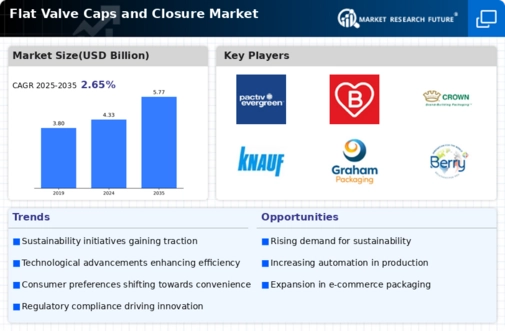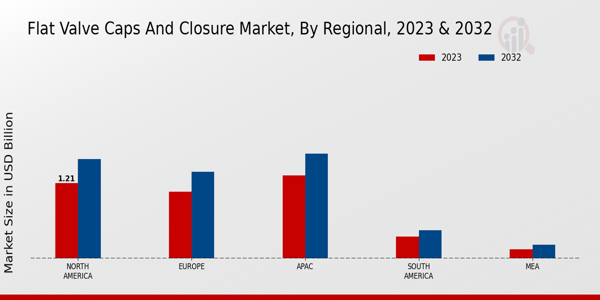Market Growth Projections
The Global Flat Valve Caps and Closure Market Industry is poised for substantial growth, with projections indicating a market size of 4.33 USD Billion in 2024 and an anticipated increase to 5.77 USD Billion by 2035. This growth trajectory suggests a compound annual growth rate (CAGR) of 2.64% from 2025 to 2035. Such projections highlight the market's resilience and adaptability in response to evolving consumer demands and industry trends. As manufacturers continue to innovate and improve their product offerings, the market is likely to witness sustained growth, driven by both established and emerging players.
Growth of the Beverage Industry
The Global Flat Valve Caps and Closure Market Industry is significantly influenced by the growth of the beverage sector. With an increasing variety of beverages, including bottled water, juices, and carbonated drinks, the demand for effective closure solutions rises correspondingly. Flat valve caps are particularly favored for their ability to maintain product freshness and prevent leakage. The beverage industry is projected to expand, contributing to the market's anticipated growth to 5.77 USD Billion by 2035. This expansion is expected to create new opportunities for manufacturers to innovate and diversify their product offerings.
Emerging Markets and Consumer Trends
Emerging markets present substantial growth opportunities for the Global Flat Valve Caps and Closure Market Industry. As economies develop, there is a rising middle class with increased purchasing power, leading to higher demand for packaged goods. This trend is particularly evident in regions such as Asia-Pacific and Latin America, where urbanization and changing consumer preferences drive the need for innovative closure solutions. The market is expected to grow at a CAGR of 2.64% from 2025 to 2035, reflecting the potential of these emerging markets to influence global consumption patterns and drive innovation in flat valve cap designs.
Rising Demand for Sustainable Packaging
The Global Flat Valve Caps and Closure Market Industry experiences a notable increase in demand for sustainable packaging solutions. As consumers become more environmentally conscious, manufacturers are compelled to adopt eco-friendly materials and designs. This shift aligns with global sustainability goals, prompting companies to innovate in their product offerings. For instance, brands are increasingly utilizing biodegradable plastics and recyclable materials in their flat valve caps. This trend not only caters to consumer preferences but also enhances brand reputation. The market is projected to reach 4.33 USD Billion in 2024, indicating a robust growth trajectory driven by sustainability initiatives.
Regulatory Compliance and Safety Standards
Regulatory compliance and safety standards are critical drivers in the Global Flat Valve Caps and Closure Market Industry. Governments worldwide are implementing stringent regulations to ensure product safety and environmental sustainability. Compliance with these regulations often necessitates the adoption of advanced closure technologies and materials. For instance, the introduction of new safety standards for food and beverage packaging compels manufacturers to invest in high-quality flat valve caps that meet these requirements. This focus on compliance not only enhances consumer safety but also fosters market growth as companies strive to adhere to evolving regulations.
Technological Advancements in Closure Design
Technological advancements play a pivotal role in shaping the Global Flat Valve Caps and Closure Market Industry. Innovations in design and manufacturing processes have led to the development of more efficient and user-friendly closure systems. For example, the integration of tamper-evident features and child-resistant designs enhances product safety and consumer trust. Additionally, advancements in materials science allow for the creation of lighter and more durable caps, which can reduce shipping costs and improve overall product performance. As these technologies evolve, they are likely to attract new investments, further propelling market growth.













